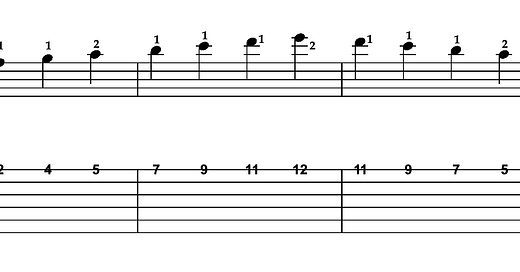For the last two essays, I have been focusing on music theory niceties through the lens of shifting on string 1. This final essay in a series makes a leap in complexity, because it combines the string-1 focus with ideas gleaned the Segovia scales.
As suggested in an earlier essay, there are many ways to finger scale steps on one string. It is not a trivial matter to choose the most appropriate fingering on the fly. Here is a default shifting pattern to become fluent with:
Finger 1 is used except when the next scale step is a half step (a minor second). This fingering emphasizes the half steps that occur between ^3 - ^4 and ^7 - ^1. While it is not the fingering for speedy shifting, it is good for leaping. One wants to “land” on finger 1 or 2.
This fingering is also good for building scaler-harmonic associations when descending a full octave in position (consider how finger 1 is always employed in bar chords). You may find technical/musical reasons to use different fingerings, but this one builds on associations with the tetrachords discussed in the Segovia-scale essays.
Once learned in other keys, it can greatly improve general fretboard knowledge, especially when leaping to a position and then leaping again within that new position (e.g., chordal skips). Pay special attention to the fingering for each tetrachord. Can you recognize the tetrachords discussed in the Segovia-scale essays?
This last exercise is a variation that may illustrate the implications of chordal skips once in a given position.
Take your time with this one! If you know about modes, there’s also a lot to consider regarding these fingerings. More on modes later.







